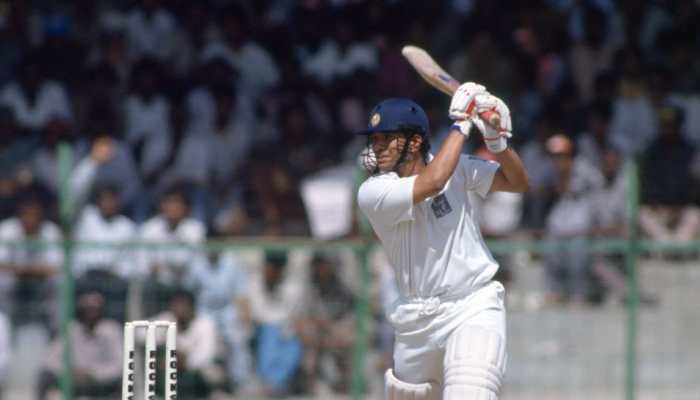Samba attack: Terrorists infiltrated through tunnel, planned to blow up trains in Jammu and Kashmir
Apart from arms, ammunition, and explosive stores, BSF recovered 10 Improvised Explosive Devices from three slain militants along IB in Ramgarh sector, Samba district.
Trending Photos
) FILE - In this October 1, 2016, file photo, Border Security Force soldiers walk with their belongings for night duty near the India-Pakistan international border area at Gakhrial boder post in Akhnoor sector.
FILE - In this October 1, 2016, file photo, Border Security Force soldiers walk with their belongings for night duty near the India-Pakistan international border area at Gakhrial boder post in Akhnoor sector. Jammu: A day after three militants were killed in a shootout with security forces near the International Border with Pakistan in Samba district of Jammu and Kashmir, the Border Security Force (BSF) on Wednesday found a tunnel in the border area.
Talking to reporters, BSF DG KK Sharma said that the terrorists killed in Samba yesterday might have crawled through an 80-metre-long tunnel under farm lands to cross the International Border.
"After the operation got over at the Chamliyal BoP (border outpost), we checked the fence and there was no breach. Then today morning, we detected a small tunnel of the size of 2x2 metres... We had deployed 'depth nakas' across the fence and hence we could detect and neutralise the three militants. The tunnel was found in a field where farming is done and has soft soil."
"The tunnel is about 75-80 metres from the IB and about 35-40 metres from the fence," he said.
Meanwhile, top officials said the militants had planned to carry out a chain of terror attacks by blowing up running trains and tracks with chained IEDs and hard to detect liquid explosives.
They added that the trio was carrying five bottles of liquid explosive trinitroglycerin.
"Militants had infiltrated to carry out big incidents. Their design was to blow up rail tracks and trains here as we have recovered chained IEDs and liquid explosives", Additional Director General (ADG) BSF and Special DG (Western Command) Arun Kumar told PTI.
They were out to carry out a chain of big impact terror incidents including blowing up of "running trains" and causing fire in trains as chain IEDs and liquid explosive are meant to blow up tracks and cause fire, he said.
"Had our troops not successfully contained and eliminated these heavily-armed terrorists with huge stores of explosive material, they could have caused massive damage in the mainland", Kumar said.
"It was only because of BSF's multi-tier security cover that this calamity was averted," the force said.
Apart from arms, ammunition and explosive stores, BSF recovered 10 Improvised Explosive Devices (IEDs) including five liquid type IEDs and three IED waist belts, five chain IEDs from three slain militants along IB in Chambiliyal belt of Ramgarh sector in Samba district yesterday.
"Chain IEDs are mainly used to blow up rail tracks and hit running trains. The five bottles of liquid explosive contained trinitroglycerin. It is used to cause explosion and trigger fire", IG BSF Jammu Frontier DK Upadhyaya said.
Terrorists are resorting to using undetectable liquid explosives like nitroglycerin now, the official said.
Nitroglycerin can be used for dynamite, explosive devices, and poison. Invented in 1847, it is made by adding acids to glycerin. Viscous and clear, it easy to conceal in lotion or shampoo bottles, an expert said.
Physical shock can start a chain reaction that breaks molecules down into carbon dioxide, water, and oxygen.
The breaking of the bonds between the atoms creates an explosion, he said.
The Jammu-Pathankot railway line is 20 kms away from the International Border (IB).
There have been several attacks targeting trains and tracks in Jammu-Samba-Kathua belts in the past.
It may be recalled that on July 27, 2015, three gunmen dressed in Army uniforms opened fire on a bus and then attacked the Dina Nagar Police Station in Gurdaspur district of Punjab after planting five chain linked bombs (IEDS) on the Amritsar-Pathankot line near Parmanand railway station, 5 kilometres from the site of the attack.
A railway trackman, while patrolling along the railway track between Dina Nagar and Jhakholari railway stations, spotted five bombs wired to a small bridge on the Amritsar-Pathankot line just before a passenger train was due to cross the bridge.
The train stopped 200 metres from the bombs. The attack resulted in the death of three civilians and four policemen, including a Superintendent of Police. Fifteen others were injured.
All three attackers were killed in the operation, which lasted almost 12 hours.
Militants crossed into IB and triggered bomb blasts on Jammu railway station on August 7, 2001, killing 12 people and injuring 29.
Similarly, infiltrating militants blew up a track in Samba on October 26, 2003. On February 10, 2000, infiltrating militants triggered blast in Shalimar Express train in Satwal in Kathua district killing five persons.
The infiltrating militants were also carrying 10 handcuffs with a design to carry out hostage taking.
"We have recovered from them 10 handcuffs in plastic. I think they were planning to carry out hostage taking as part of engineering terror incidents", the IG said.
Three AK-47 rifles, a pistol, 20 magazines, 514 AK rounds, a pistol magazine, 16 pistol rounds, 31 live grenades, 10 IEDS including 5 IED waist belts, five chain IEDs (used to blow up railway tracks), Global Positioning System (GPS), one mobile, two wireless sets with chargers, 2 knives, 2 dressing rolls, 2 jackets, 3 bags, one head gear, one lighter, 3 gloves, 5 dry fruit packets and Pakistan made eatables were recovered from the slain terrorists in Ramgarh sector yesterday.
Meanwhile, addressing journalists on the eve of the Border Security Force's 51st Raising Day, BSF DG KK Sharma said that a concerted effort has been made to modernise border fences but added that there was no technology to detect a tunnel.
The DG said the border guarding force would take up the matter with its counterparts -- Pakistan Rangers, but added that due to increased hostilities, the other side is not "getting in touch" for quite some time now.
BSF officials said there is "ample proof" and an indication to say that the militants crawled through the tunnel to reach this side of the border.
Sharma said the Nagrota attack that took place yesterday at an Army camp was "separate" and it was part of the investigation to find out if it had any connection with the Samba terror bid.
He said that since the increase of hostilities between the two sides, especially post the surgical strikes conducted by the army across the Line of Control, BSF has killed 15 Pakistani Rangers and 10 militants while it lost five troops.
"For the last 15 days, there has been no shelling along the IB. Post the surgical strikes we knew that infiltration attempts and attacks would increase along the IB which we exclusively guard and hence anticipating trouble we have been prepared against such attempts," he said, adding it was pitch dark last night hence picking up movements along the IB was difficult through the naked eye.
Sharma said BSF had "strong inputs that infiltration can be attempted from around the IB area and that is why we were in a position to effectively neutralise the three" yesterday.
The violence on Tuesday followed days of calm on the border and the Line of Control (LoC) between Indian and Pakistani forces.
The two sides have been exchanging heavy mortar and artillery fire for months after the Uri attack.
Following that, the Indian Army destroyed at least seven terror launch pads and killed an unknown number of terrorists and sympathisers across the LoC in Pakistani Kashmir.
(With Agency inputs)
Stay informed on all the latest news, real-time breaking news updates, and follow all the important headlines in india news and world News on Zee News.
Live Tv







)
)
)
)
)
)
)
)
)
)
